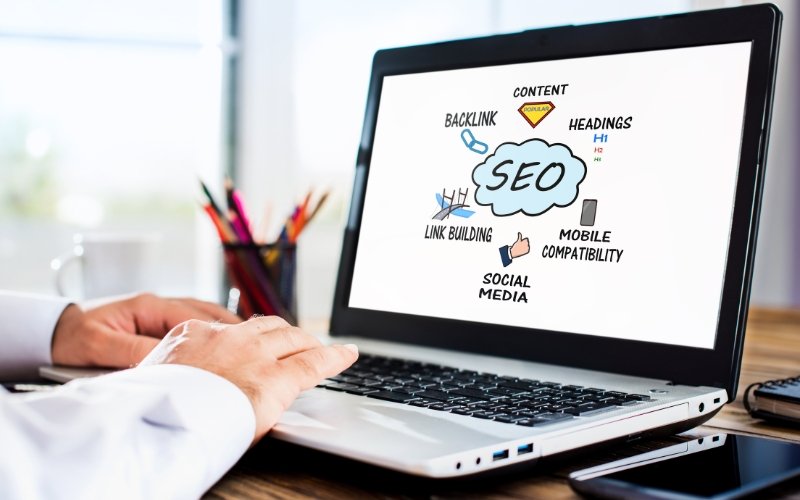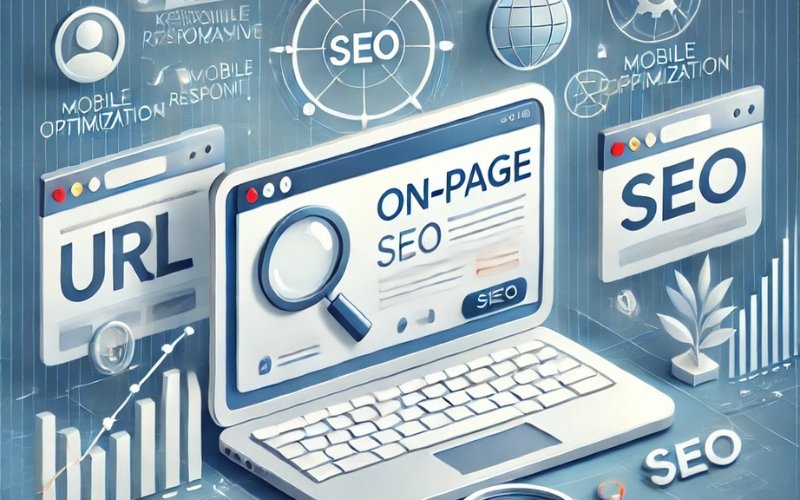When it comes to SEO, the content you produce is only part of the equation. The technical aspects of on-page SEO are just as critical in helping your content rank higher in search engine results. On-page SEO refers to the process of optimizing the elements on your website that search engines use to understand what your content is about. From URL structure to image optimization, a well-optimized page can make all the difference in attracting organic traffic.
This article will guide you through the essential steps to optimize your on-page SEO for better rankings.
URL Structure: Simple and Keyword-Focused

The URL structure is one of the first things both users and search engines see, so it needs to be clean and relevant. A well-optimized URL can improve user experience, increase click-through rates, and enhance SEO.
Best practices for URL optimization:
- Keep URLs short, descriptive, and easy to read.
- Include your primary keyword in the URL.
- Use hyphens to separate words, avoiding underscores or other characters.
- Avoid using unnecessary words like “and,” “of,” or “the.”
For example, instead of using a URL like “https://example.com/p=2345“, aim for something like “https://example.com/seo-tips.”
Title Tag Optimization: Crafting Compelling Titles
Title tags are one of the most critical elements of On-Page SEO. They serve as the first impression for both users and search engines, conveying the essence of your webpage’s content. A well-optimized title tag can significantly impact click-through rates (CTR) and search rankings, making it essential to craft them with precision and strategy. By following best practices for title tag optimization, you can improve your website’s visibility and attract the right audience.
Why Title Tags Matter for On-Page SEO
Title tags are not just placeholders for keywords; they are a strategic component of On-Page SEO. They inform search engines about the page’s content and purpose, which helps determine its relevance to specific queries. A poorly optimized title tag can result in lower rankings, reduced traffic, and missed opportunities to engage users. Crafting a compelling, keyword-focused title ensures that your content aligns with user intent while adhering to search engine guidelines.
Key Tips for Optimizing Title Tags
- Use Your Primary Keyword Strategically
Including your primary keyword near the beginning of the title is crucial for effective On-Page SEO. Search engines give higher weight to words that appear earlier in the title, so placing your main keyword upfront helps improve visibility and relevance. For instance, a title like “On-Page SEO: Best Practices for Higher Rankings” performs better than “Learn About Best Practices for On-Page SEO.”
- Keep Titles Concise
Title tags should be under 60 characters to prevent truncation in search results. A concise title ensures that users see the complete message, which is key to encouraging clicks. Long titles risk losing important information, diminishing their impact on both users and On-Page SEO performance.
- Make Titles Engaging
Creating an enticing title encourages users to click through to your site. Incorporate action-oriented words, numbers, or questions to pique curiosity. For example, “10 On-Page SEO Tips to Skyrocket Your Rankings” is more engaging than “SEO Tips.”
- Avoid Keyword Stuffing
While it’s important to use keywords, avoid cramming multiple keywords into the title. This practice can make titles appear spammy and reduce their effectiveness for both users and On-Page SEO. Instead, focus on creating a natural, user-friendly title that flows well.
Examples of Optimized Title Tags for On-Page SEO
To better understand how title tag optimization works in practice, consider these examples:
- Poor Title: “On-Page SEO Information”
- Optimized Title: “5 On-Page SEO Strategies to Boost Website Rankings”
The second example is concise, includes a keyword early, and uses a specific, actionable format that is more likely to attract clicks.
Beyond Keywords: Adding Value to Title Tags
Effective title tags go beyond keyword usage. They should also reflect the value your content offers. Think about the user’s perspective—what problem does your content solve, and how can you communicate that in the title? A value-driven approach not only improves On-Page SEO but also enhances user satisfaction, leading to higher engagement rates.
Testing and Refining Title Tags
To ensure your title tags are performing well, use tools like Google Search Console or A/B testing software. These tools help analyze CTR and identify which titles resonate most with your audience. Regularly updating underperforming titles is an integral part of On-Page SEO maintenance.
Optimizing your title tags is one of the simplest yet most effective ways to improve On-Page SEO. By combining keyword strategy, user-focused content, and continuous refinement, you can create compelling titles that drive clicks and enhance search engine visibility
Meta Descriptions: Boosting Click-Through Rates

Meta descriptions are short summaries of your content that appear in search results beneath your title. Although they are not a direct ranking factor, they can significantly impact your click-through rate (CTR).
How to write effective meta descriptions:
- Keep it under 160 characters.
- Use action-oriented language that encourages users to click.
- Include your primary keyword naturally.
A well-written meta description can improve your visibility and attract more visitors to your page.
Heading Tags: Structuring Your Content
Search engines use heading tags (H1, H2, H3, etc.) to understand the hierarchy of your content. Proper use of heading tags helps both users and search engines navigate your page more easily.
Best practices for heading tags:
- The H1 tag should contain the main keyword and describe the content of the page.
- Use H2 and H3 tags to break down the content into organized sections.
- Avoid using multiple H1 tags on the same page, as this can confuse search engines.
Well-structured content enhances user experience and can lead to better rankings.
Internal Linking: Building a Strong Site Structure
Internal linking is a crucial on-page SEO factor that helps search engines crawl your site and understand the relationship between your pages. It also keeps users engaged with your content for longer.
How to optimize internal links:
- Link to relevant pages within your site to provide additional value to readers.
- Use descriptive anchor text that tells users and search engines what the linked page is about.
- Avoid overloading pages with too many internal links, which can dilute the link juice passed on to other pages.
Image Optimization: Boosting Page Load Speed

Images can enhance your content, but they need to be optimized for both speed and SEO. Large, uncompressed images can slow down your page load time, which can negatively impact both user experience and SEO.
Tips for optimizing images:
- Compress images to reduce file size without compromising quality.
- Use descriptive file names and include keywords where appropriate.
- Add alt text to describe images, which helps search engines index them.
Optimized images improve both page load times and accessibility, providing a better overall experience for users.
Mobile Optimization: Catering to Mobile-First Indexing
In today’s digital landscape, mobile optimization is no longer optional—it’s essential. With Google’s shift to mobile-first indexing, the search engine primarily considers the mobile version of your site for ranking and indexing. This change underscores the importance of ensuring your website delivers a seamless experience on smartphones and tablets. A mobile-optimized site not only caters to a growing number of mobile users but also enhances your chances of achieving higher rankings in search results.
What is Mobile-First Indexing?
Mobile-first indexing means that Google predominantly uses the mobile version of your website for indexing and ranking. If your mobile site is poorly optimized, it can negatively impact your overall rankings, even if your desktop site is well-designed. This shift aligns with the global increase in mobile internet usage, where more users access websites via their smartphones than desktops.
Best Practices for Mobile Optimization
- Responsive Design
A responsive design ensures that your website automatically adjusts to different screen sizes, offering a consistent experience across devices. This eliminates the need for separate desktop and mobile versions, streamlining content updates and maintenance. - Optimize Page Speed
Mobile users expect fast-loading pages. Compress images, minify CSS and JavaScript, and leverage browser caching to improve page speed. Tools like Google’s PageSpeed Insights can help identify and resolve speed-related issues. - User-Friendly Navigation
Buttons and links should be easily clickable without accidental misclicks. Ensure adequate spacing between clickable elements and use a font size that is legible on smaller screens. - Mobile-Friendly Content
Simplify your content layout for mobile devices. Use shorter paragraphs, bullet points, and headings to make it easier for users to scan information quickly.
Benefits of Mobile Optimization
A mobile-optimized site enhances user experience by ensuring visitors can access your content effortlessly. It reduces bounce rates, increases engagement, and builds trust with your audience. Additionally, search engines prioritize mobile-friendly websites, giving you a competitive edge in rankings. Adopting mobile optimization best practices not only improves your site’s usability but also positions you favorably in the era of mobile-first indexing.
Conclusion
Optimizing your on-page SEO is essential for improving your content’s visibility and ranking potential. By focusing on key elements like URL structure, title tags, meta descriptions, heading tags, internal linking, image optimization, and mobile responsiveness, you can create a user-friendly experience that search engines will reward. Implementing these best practices will set you on the path to higher rankings, increased traffic, and better user engagement.

